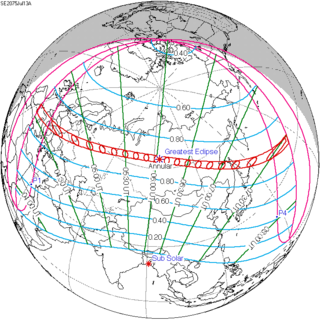Solar eclipse of July 13, 2075
| Solar eclipse of July 13, 2075 | |
|---|---|
| Type of eclipse | |
| Nature | Annular |
| Gamma | 0.6583 |
| Magnitude | 0.9467 |
| Maximum eclipse | |
| Duration | 285 s (4 min 45 s) |
| Coordinates | 63°06′N 95°12′E / 63.1°N 95.2°E |
| Max. width of band | 262 km (163 mi) |
| Times (UTC) | |
| Greatest eclipse | 6:05:44 |
| References | |
| Saros | 147 (26 of 80) |
| Catalog # (SE5000) | 9676 |
An annular solar eclipse will occur on July 13, 2075. A solar eclipse occurs when the Moon passes between Earth and the Sun, thereby totally or partly obscuring the image of the Sun for a viewer on Earth. An annular solar eclipse occurs when the Moon's apparent diameter is smaller than the Sun's, blocking most of the Sun's light and causing the Sun to look like an annulus (ring). An annular eclipse appears as a partial eclipse over a region of the Earth thousands of kilometres wide.
Eight european capitals will observe annual eclipse: Monaco, San Marino, Ljubljana, Zagreb, Vienna, Bratislava, Budapest and Moscow.
Related eclipses
Solar eclipses 2073-2076
This eclipse is a member of a semester series. An eclipse in a semester series of solar eclipses repeats approximately every 177 days and 4 hours (a semester) at alternating nodes of the Moon's orbit.[1]
The partial solar eclipses on June 1, 2076 and November 26, 2076 occur in the next lunar year eclipse set.
| Solar eclipse series sets from 2073 to 2076 | ||||||
|---|---|---|---|---|---|---|
| Descending node | Ascending node | |||||
| Saros | Map | Gamma | Saros | Map | Gamma | |
| 122 | February 7, 2073 Partial |
1.1651 | 127 | August 3, 2073 Total |
−0.8763 | |
| 132 | January 27, 2074 Annular |
0.4251 | 137 | July 24, 2074 Annular |
−0.1242 | |
| 142 | January 16, 2075 Total |
−0.2799 | 147 | July 13, 2075 Annular |
0.6583 | |
| 152 | January 6, 2076 Total |
−0.9373 | 157 | July 1, 2076 Partial |
1.4005 | |
References
- ^ van Gent, R.H. "Solar- and Lunar-Eclipse Predictions from Antiquity to the Present". A Catalogue of Eclipse Cycles. Utrecht University. Retrieved 6 October 2018.
External links
- Earth visibility chart and eclipse statistics Eclipse Predictions by Fred Espenak, NASA/GSFC




